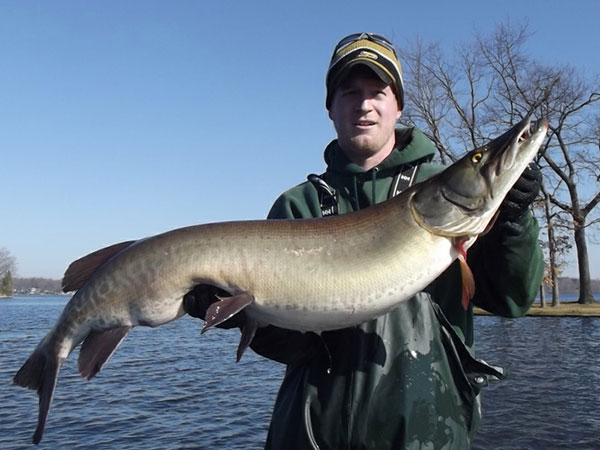By Louie Stout
 Webster Lake muskies under study.An apparent decline in muskies on Webster Lake will be the focus of a fisheries study this spring and summer.
Webster Lake muskies under study.An apparent decline in muskies on Webster Lake will be the focus of a fisheries study this spring and summer.
The popular Kosciusko County lake has been heralded as one of the Midwest’s top muskie hotspots over the past decade, but catch numbers are declining and biologist Jed Pearson wants to know why.
“Anglers say they aren’t seeing the younger muskies that they were 10 years ago, so it’s time to go take a look at it,” he said.
Fishing guides – most of whom practice catch and release – say the number of muskies they are seeing is down from previous years, although fishing last year was a slight improvement over the year before.
A fisheries team began netting there this week and will continue doing so over the next few weeks. Captured muskies will be marked, documented and released.
In 2005, Webster surveys revealed the highest muskie population per acre than any other Midwestern lake.
“We’ve seen a gradual increase in the overall size and I suspect we will find fewer adults this year than we have in the past,” Pearson said. “That’s why we want to get out there and get an estimate of the population.”
In fact, the biologist’s crew trapped a 48-incher among the 10 they collected on Tuesday and another 48.5-incher Thursday.
If the study shows a decline in muskie numbers, Pearson plans to find out why.
There could be several reasons for it.
Anglers point to the heavy weed kills administered by the lake association in 1998, 2002 and again in 2010. The heavy dose of chemicals applied to lake-wide vegetation left the bottom barren and turned the water cloudy for a few years after the 2010 application. Vegetation started coming back the past two years.
“The weed kills are a concern,” said Pearson. “But it’s possible that other factors have come into play.”
Pearson has been concerned that the lack of vegetation and cover makes newly stocked muskies susceptible to heavy predation by larger predators during the winter months.
“We had a lot of adult muskies in the lake a few years ago, so predation could be a factor,” he explained. “But it also could mean that the population is beginning to stabilize and move to a more realistic balance that is more suitable for that lake.”
Another factor could be a change in how young muskies are reared at the hatchery. The hatchery plan previously fed minnows to young muskies minnows for 90 days before releasing them, but that was changed to 30 days.
“I’m certainly not blaming the hatchery, but that could have affected the overall condition of the fish at the time they were stocked,” Pearson said. “We’ve since bumped it up to 45 days on a minnow diet.”
About 3,800 muskies measuring 8 to 10 inches are stocked annually.
There also is some discussion of changing the timing of the stocking. The muskies currently go into the lake in the fall, but consideration is being given to stocking some the following spring. It’s a practice that has worked for other states.
“That puts them in the lake during a time in which the forage base is the largest of the year because so many other fish are finishing up their spawning,” he said. “I’m not implying there is a forage shortage – there’s plenty of shad and other stuff for fish to eat. But stocking in the spring could give the young muskies access to smaller forage.”
Pearson said the study will take two years to complete, but he hopes to learn more as in the coming year.





